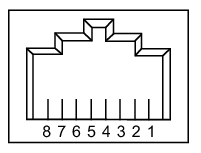Remote programming and operation of the BTS Master is accessed via the Ethernet or the USB interface. The following paragraphs provide information about the interface connections, cable requirements, and setting up remote operation.
The MT822xB fully supports the IEEE-802.3 standard. Most MT822xB functions (except power on/off) can be controlled via an Ethernet connection to a PC connected directly (with an Ethernet cross-over cable) or through a network. The MT822xB software supports the TCP/IP network protocol.
Ethernet networking uses a bus or star topology where all of the interfacing devices are connected to a central cable called the bus, or are connected to a hub. Ethernet uses the CSMA/CD access method to handle simultaneous transmissions over the bus. CSMA/CD stands for Carrier Sense Multiple Access/Collision Detection. This standard enables network devices to detect simultaneous data channel usage, called a collision, and provides for a contention protocol. When a network device detects a collision, the CSMA/CD standard dictates that the data is retransmitted after waiting a random amount of time. If a second collision is detected, the data is again retransmitted after waiting twice as long. This is known as exponential back off.
|
•
|
IP Address: Every computer/electronic device in a TCP/IP network requires an IP address. An IP address has four numbers (each between 0 and 255) separated by periods. For example: 128.111.122.42 is a valid IP address.
|
|
•
|
Subnet Mask: The subnet mask distinguishes the portion of the IP address that is the network ID from the portion that is the station ID. The subnet mask 255.255.0.0, when applied to the IP address given above, would identify the network ID as 128.111 and the station ID as 122.42. All stations in the same local area network should have the same network ID, but different station IDs.
|
|
•
|
Default Gateway: A TCP/IP network can have a gateway to communicate beyond the LAN identified by the network ID. A gateway is a computer or electronic device that is connected to two different networks and can move TCP/IP data from one network to the other. A single LAN that is not connected to other LANs requires a default gateway setting of 0.0.0.0. If you have a gateway, then the default gateway would be set to the appropriate value of your gateway
|
|
•
|
Ethernet Address: An Ethernet address is a unique 48-bit value that identifies a network interface card to the rest of the network. Every network card has a unique ethernet address (MAC address) permanently stored into its memory.
|
Interface between the BTS Master and other devices on the network is via a category five (CAT-5) interface cable connected to a network. This cable uses four twisted pairs of insulated copper wires terminated into an RJ45 connector. CAT-5 cabling is capable of supporting frequencies up to 100 MHz and data transfer speeds up to 1 Gbps, which accommodates 1000Base-T, 100Base-T, and 10Base-T networks. CAT-5 cables are based on the EIA/TIA 568 Commercial Building Telecommunications Wiring Standard developed by the Electronics Industries Association. A pinout diagram is shown in Table: “8-pin Ethernet RJ45 Connector Pinout Diagram”.
TCP/IP connectivity requires setting up the parameters described at the beginning of this section. The following is a brief overview of how to set up a general LAN connection on the MT822xB.
|
You may need to consult your network documentation or network administrator for assistance in configuring your network setup.
|
The RJ‑45 connector is used to connect the BTS Master to a local area network. Integrated into this connector are two LEDs. The amber LED indicates the presence of LAN voltages (a live LAN connection) while the green LED flashes to show that LAN traffic is present. The instrument IP address is set by pressing the Shift key, then the System (8) key followed by the System Options soft key and the Ethernet Config soft key. The instrument IP address can be set automatically using DHCP, or manually by entering the desired IP address, gateway address and subnet mask.
|
An active Ethernet cable must be connected to the MT822xB before it is turned ON in order to enable the Ethernet port for DHCP or for a static IP address.
Depending upon local conditions, the port may remain enabled when changing from DHCP to static IP address, when changing from static IP address to DHCP, or when temporarily disconnecting the Ethernet cable.
If the port becomes disabled, ensure that an active Ethernet cable is attached to the MT822xB and then cycle the power OFF and back ON.
|
Dynamic Host Configuration Protocol (DHCP) is an Internet protocol that automates the process of setting IP addresses for devices that use TCP/IP, and is the most common method of configuring a device for network use. To determine if a network is set up for DHCP, connect the MT822xB to the network and select DHCP protocol in the Ethernet Config menu.
Power cycle the BTS Master. If the network is set up for DHCP, then the assigned IP address should be displayed briefly after the power‑up sequence.
To display the IP address of the instrument on, press the Shift key, then the System (8) key, then the System Options soft key and the Ethernet Config soft key.

